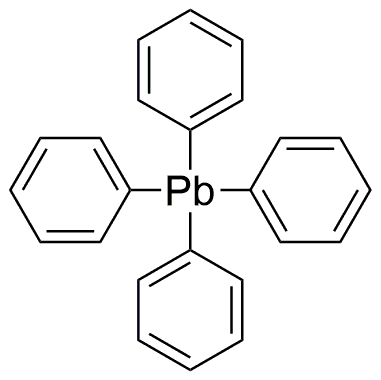Tetraphenyl lead is widely utilized in research focused on:
- Organic Synthesis: It serves as a reagent in various organic reactions, particularly in the synthesis of organolead compounds, which are important for developing new materials and pharmaceuticals.
- Electronics: This compound is used in the production of certain types of semiconductors and electronic devices, leveraging its unique electrical properties to enhance performance.
- Research in Catalysis: Tetraphenyl lead acts as a catalyst in chemical reactions, improving reaction rates and selectivity, which is crucial for efficient chemical manufacturing processes.
- Environmental Studies: It is employed in studies examining the behavior of lead compounds in the environment, helping researchers understand pollution and develop remediation strategies.
- Analytical Chemistry: The compound is used in analytical methods for detecting and quantifying lead in various samples, providing essential data for safety and regulatory compliance.
General Information
Properties
Safety and Regulations
Applications
Tetraphenyl lead is widely utilized in research focused on:
- Organic Synthesis: It serves as a reagent in various organic reactions, particularly in the synthesis of organolead compounds, which are important for developing new materials and pharmaceuticals.
- Electronics: This compound is used in the production of certain types of semiconductors and electronic devices, leveraging its unique electrical properties to enhance performance.
- Research in Catalysis: Tetraphenyl lead acts as a catalyst in chemical reactions, improving reaction rates and selectivity, which is crucial for efficient chemical manufacturing processes.
- Environmental Studies: It is employed in studies examining the behavior of lead compounds in the environment, helping researchers understand pollution and develop remediation strategies.
- Analytical Chemistry: The compound is used in analytical methods for detecting and quantifying lead in various samples, providing essential data for safety and regulatory compliance.
Documents
Safety Data Sheets (SDS)
The SDS provides comprehensive safety information on handling, storage, and disposal of the product.
Product Specification (PS)
The PS provides a comprehensive breakdown of the product’s properties, including chemical composition, physical state, purity, and storage requirements. It also details acceptable quality ranges and the product's intended applications.
Certificates of Analysis (COA)
Search for Certificates of Analysis (COA) by entering the products Lot Number. Lot and Batch Numbers can be found on a product’s label following the words ‘Lot’ or ‘Batch’.
*Catalog Number
*Lot Number
Certificates Of Origin (COO)
This COO confirms the country where the product was manufactured, and also details the materials and components used in it and whether it is derived from natural, synthetic, or other specific sources. This certificate may be required for customs, trade, and regulatory compliance.
*Catalog Number
*Lot Number
Safety Data Sheets (SDS)
The SDS provides comprehensive safety information on handling, storage, and disposal of the product.
DownloadProduct Specification (PS)
The PS provides a comprehensive breakdown of the product’s properties, including chemical composition, physical state, purity, and storage requirements. It also details acceptable quality ranges and the product's intended applications.
DownloadCertificates of Analysis (COA)
Search for Certificates of Analysis (COA) by entering the products Lot Number. Lot and Batch Numbers can be found on a product’s label following the words ‘Lot’ or ‘Batch’.
*Catalog Number
*Lot Number
Certificates Of Origin (COO)
This COO confirms the country where the product was manufactured, and also details the materials and components used in it and whether it is derived from natural, synthetic, or other specific sources. This certificate may be required for customs, trade, and regulatory compliance.


